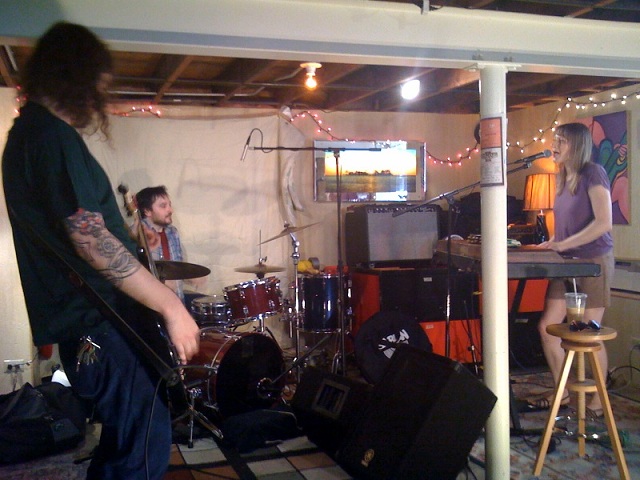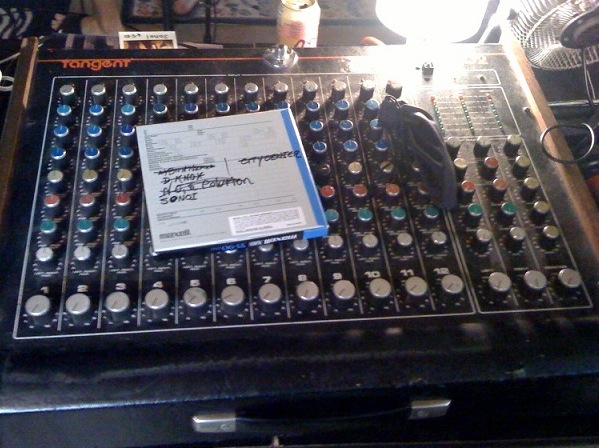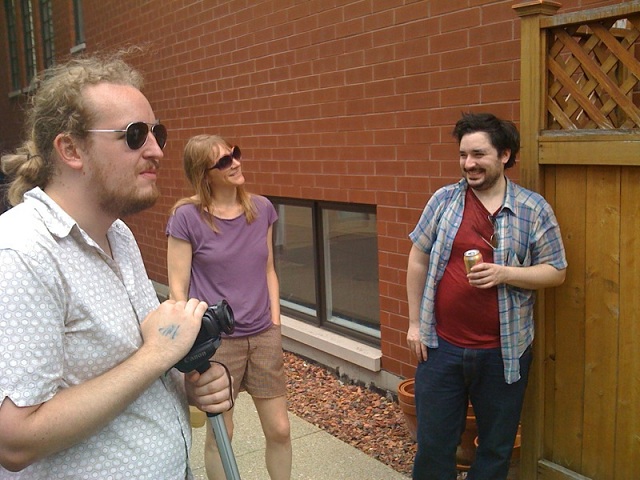Coach House Sounds Brings Analog Recording To A Digital World
By Jon Graef in Arts & Entertainment on Jul 22, 2010 7:00PM
For all of the hectic planning that can comprise a Coach House Sounds session—the emailing, the working around weekend and employment schedules, the driving of artists to venues so they can make their shows at the last minute—the people behind CHS are remarkably calm as I arrive to their headquarters on an overcast Sunday afternoon in early June for a pre-session chat and observation. It’s half-an-hour before post-punk minimalists Reds and Blue are due to show up to record their session, which will be one of three scheduled for the weekend. For a project that started in a guy’s basement, that’s a lot of activity.
Set in founder Matt Baron’s…well, coach house, in Lakeview, Coach House Sounds has a unique concept for a website, even amongst websites with unique concepts: Using second-hand analog tape equipment (an AKAI GX-4000D and Tangent Mixer ), Coach House Sounds records both local and touring bands in an surprisingly eclectic array of genres, then uploads the session digitally to their website, where listeners can stream the results in their entirety.
The session is documented with at least two different tape and digital video cameras, which is then edited into a single film. Photographs are taken as well, for additional posterity. The main goal of Coach House, according to Baron “is to allow bands something that they can promote themselves…and building an archive of various genres. We’ve done a lot of touring bands at this point, which are great, but there’s so much excellent music in Chicago. It’s a little bit easier to schedule [local acts], and it’s less of a rush. We can do weekends where it’s more laid-back.”
It’s on such a laid-back weekend that I arrived to watch the foursome who comprise Coach House Sounds execute a session. Reds and Blue is here to record a session of songs from its upcoming record, Son of the Stars, to be released on Addenda Records in August. Because of the nature of the tape machine, no overdubs are allowed—an approach that can encourage both raw intimacy and fevered improvisation, depending on which group happens to be in the basement that day. Through an hour of setting up, using whatever equipment the band happens to bring, as well as instruments around the basement (including Baron’s drum kit), each band will typically play a 45-minute to an hour long set. Re-takes only happen if the band in question is dissatisfied with the take or majorly fumbles a song.
Though engineer Doug Leinen stresses that it’s ultimately up to the band as to what they actually play, expanding the group’s sonic comfort zone in a comfortable zone is what Coach House does best “It’s fun because it’s not necessarily a studio space, because we don’t use headphones [during recording], but it’s not a live show either with an audience. It can be the fun parts of both…”
Baron agrees, adding that “Even if the studio is a more relaxed atmosphere…there’s something inherently sterile about having glass between the engineer and the band. [The basement] puts them in a space of comfort that they don’t [normally] have.”
It’s the basement’s atmosphere, adorned with scenic ocean paintings, a wall of Polaroid featuring past participants, and out-of-season Christmas lights, that puts artists in the mind-frame of experimentation and improvisation—something that Leinen says is encouraged wholesale: “With the equipment, something that’s straight from the album will sound like the album, but recorded on tape. Without being able to do overdubs, the band can do something a little different.”
As examples, Leinen cites post-hop duo Kid Static, who experimented with a loop pedal purchased hours before their scheduled session, and local jazz veteran Jeb Bishop, who incorporated the house glockenspiel mid-song. Because of the unusual circumstances involved, fortuitous creativity seems all but inevitable.
Chance seems to be the watchword when it comes to Coach House Sounds. The four Coach House members—Baron, Leinen, filmmaker and videographer Mike Mayer, and Neil Morrison, who designed the Coach House Session logo and takes the pictures and Polaroids that adorn the site—all came together through chance, essentially, meeting through a mutual acquaintance, Brian Goodheart who engineered a record for one of Baron’s bands, Baron Von Something. That inspired Baron to think of the site idea, and the rest came aboard one-by-one. That friend-through-a-friend principle is often times how Coach House finds groups to record for them. Baron says that he’ll often come about bands through avenues like CHIRP or friends at labels. Reds and Blue, for instance, was suggested to Coach House by Kumar McMillian, co-head of cassette boutique label Plustapes, whose vinyl sister label, Addenda, is set to release the trio's debut album.
Around noon, the band -- consisting of organist Ellen Bunch, bassist Pete Croke and drummer Areif Sless-Kitain -- shows up, a little hesitant as to whether or not this is the right place. Once they are greeted by the CHS foursome with the familiarity of passionate fans, they relax. The band begins set-up, and there’s a laid-back professionalism that drives the undercurrent of the session. You wouldn’t expect four guys who appeared to have just rolled out of bed to be able to quickly EQ a mic and establish a balanced mix, but Leinen does so promptly. Once he works with Sless-Kitain on how to properly close-mic the drums and the instruments - too much of either can result in a poor mix - everything is ready to go. All the while, Baron is talking amp shop with Croke, and Meyer and Morrison set themselves up for optimal shooting placement.
To start off, Reds and Blue run through one song so that Leinen can get the mix, which he does so quickly. Reds and Blue minimal organ-drum-bass set-up may be the considering factor. Once Bunch introduces the first song with a charming jitteriness that she says is due to too much coffee, the band is off and running. Baron nods his head to the beat, while Morrison quietly snaps pics, careful not to intrude too much on the band's space. Leinen attentively watches the band and the mix, making sure that nothing is out of balance. Meyer, for his part, stays as still as possible, since his motions will result in shaky footage. But you can tell that he's digging it. Says Meyer: "I’m continually blown away by all of the creative people who come through these doors."
With the lights for the video in the close quarters of the basement, Reds and Blue appear flushed, but not overwhelmed, by the heat as they run through their post-punk minimalist jams. The rhythm section is taut, Sless-Kitain hunched over his drum kit, looking like Robert DeNiro as a Buddy Rich-tutored snare machine. Bunch is insanely creative with the types of sounds she elicits from her amp and organ. She introduces each song enthusiastically with joke-y banter, and the band makes nary a mistake. After a run-through of songs from Stars, the session is over, with everyone remarking as to how quickly it all came together. Afterward, everyone hangs outside in the backyard, chatting about music and complimenting one another on a job well done. Meyer does note, though, that efficiency isn’t necessarily beneficial: Ask him about how he earned his “Chicago taxi driver badge” in driving hip-hop act Astronautalis to the Bottom Lounge after a whirlwind same-day session, getting him there 5 minutes before he was scheduled to go on.
Here's how it goes online: Leinen records the tape to the site’s computer for archival purposes. He uses studio software Reaper to compress the audio, then sends out MP3s to Baron and the band. Meyer edits the footage he shoots - usually with a handheld camera or one on a tripod - using Final Cut Pro. Once the band approves the MP3s, and the video is edited, the session goes live, usually in tandem with a Coach House-sponsored show, or a CD release party. (As will be the case for Reds and Blue, who will play an Addenda showcase with Coach House Sounds alums Hollows to celebrate Stars' release).
Reds & Blue - 06.06.10 from Coach House Sounds on Vimeo.
As far as what bands will be featured in Coach House in the future, Baron has a wish list of sorts, comprising Word documents and Excel spreadsheets, based on what acts he hears as well as suggestions from Leinen, Mayer and Morrison. Included on the list are Chicago metal bands like Yakuza and Indian, as well as groups and artists like Cave, Ken Vandermark and Shellac. (Meyer and Morrison's suggestions of U2 and Coldplay were, quite possibly, sarcastic).
Whatever the genre the musicians happen to fall in, a distinctive sound is key to pique Coach House's interest to schedule a recording. Baron says, is “If a band sounds unique on the first listen… I don’t want this to be ‘Matt House Sounds.’ So it’s not necessarily things that I have to love. I do like everything that’s come in here, and I most of it I love… Sometimes it’s really tough to tell on MySpace, because it’s sometimes all that bands have.” Given that most bands send MySpace clips as an example of their work, determining if a band is unique is something that’s harder and harder to do. But, in marrying analog recording and equipment with digital distribution methods, Coach House seems to be aiming for a truce, not just in the typical debate over “analog vs. digital” aesthetics, but in the very nature that music itself is consumed.
Is music listening now better since we can access thousands upon thousands of songs with a single click? Or were music appreciators better off when they had to get up and lift a record needle in order to change sides of an album? Ultimately, these questions are rhetorical. Coach House uses technology’s capacity to reach as wide an audience as possible to stimulate exploratory listening -- “slow listening”, if you will. Coach House Sounds’ most recent iteration of its site has been up for only 10 months, but there’s a decidedly anti-scrolling design at play. That design is a deliberate choice, according to Baron: “We’re still developing it, but we’re trying to make our site just as simple as possible.” Meyer says that although he doesn't "want to necessarily institutionalize the thinking behind" Coach House Sounds, he nonetheless admits that, "I feel like we’re a little more album-oriented in our presentation, as opposed to single-oriented.”
While the site is currently working on a way to release podcasts, the aim now will be to encourage traffic to its website. Of the original design, Leinen says that they were originally not going to include a skip button with the player on the site. But they decided against that move, adding the button. As Leinen admits practically, in a digital age, “people don’t have that much time.” Meyer adds, “Sometimes you just have to skip through and just kind of check something out.”
Coach House Sounds presents Pomegranates, Josh Mease & Sad Brad Smith at Schubas on Friday July 23, 10 p.m. $10, 21+
Reds and Blue Record Release show with Hollows and Royce on Friday, July 30, 10 p.m., $10, 21+



